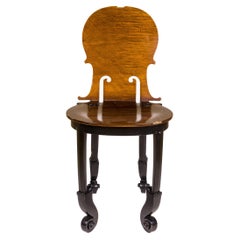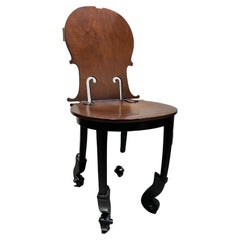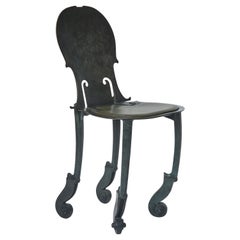Arman Cello Chair
Arman "Cello" Chair, circa 1990, France
By Arman, Hugues Chevalier
Located in Girona, Spain
Arman "Cello" Chair, circa 1990, France.
Arman "Cello" chair editions Hugues Chevalier n°9/50
Category
1990s French Modern Side Chairs
Materials
Beech
Recent Sales
Arman Cello Chair, Circa 1990
By Arman
Located in PARIS, FR
Arman Cello chair circa 1990
Éditions Huge Chevalier
Excellent condition
Arman ( 1928
Category
1990s French Mid-Century Modern Chairs
Materials
Wood, Beech
Cello Chair
By Arman
Located in PARIS, FR
Bronze, leather upholstery Fonderie d’art Bocquel, numbered.
Category
1990s French Chairs
Materials
Bronze
Cello Chair
By Arman
Located in PARIS, FR
Bronze, leather upholstery Fonderie d’art Bocquel, numbered.
Category
1990s French Chairs
Materials
Bronze
Cello Chair
By Arman
Located in PARIS, FR
Bronze, leather upholstery Fonderie d’art Bocquel, numbered.
Category
1990s French Chairs
Materials
Bronze
Arman Pair of Cello Chairs in Bronze Antique Green Patina and Green Leather Seat
By Arman
Located in Paris, FR
xx/1800.
Bocquel Foundry.
Recorded at the Arman Studio in New York under number: APA # 7030.93.414
Category
1990s Figurative Sculptures
Materials
Bronze
H 33.47 in W 16.54 in D 13.78 in
Unique Creation of Arman, 'CELLO' Chair, Editions Hugues Chevalier
By Arman
Located in Beirut, LB
Cello chair by Arman Hugues Chevalier editions n ° 2/50.
Wood (sycamore and beech), France
Category
Late 20th Century French Mid-Century Modern Chairs
Materials
Wood
Cello Chair by Arman, Number 4/50, Wood, France
By Arman
Located in Paris, FR
Cello chair by Arman editions Hugues Chevalier n°4/50. Wood (sycamore and beech), France.
Signed
Category
Early 2000s French Chairs
Materials
Beech, Sycamore
People Also Browsed
Rosso Wall Mirror
By Specchi Veneziani
Located in Milan, IT
Venetian mirror made in the strictest Murano tradition. Assembled with crystal/gold and red elements handmade in the Murano furnaces. Wooden frame with a natural finish.
Category
2010s Italian Renaissance Wall Mirrors
Materials
Glass
Violin Armchair
By Arman
Located in PARIS, FR
Bronze, leather upholstery
Fonderie d’art Bocquel, signed on the back.
Category
1990s French Armchairs
Materials
Bronze
Pair of Sculptural Bronze Armchairs by Arman Fernandez
By Arman Fernandez
Located in Bridgewater, CT
"Fauteuil Violon", pair of patinated bronze armchairs by Arman (Pierre Fernandez Armand, 1928 - 2005) with leather seat. Signed, numbered, with "Bocquel Fd" foundry mark.
Category
Late 20th Century French Mid-Century Modern Armchairs
Materials
Bronze
Vintage Metal Violin Chair in the Style of Arman
By Arman
Located in Brooklyn, NY
This unique vintage side chair features the unique design of Fernandez Arman, drawing inspiration from the violin. Unique feet resemble the instruments headstock while the seat and b...
Category
Early 20th Century Mid-Century Modern Chairs
Get Updated with New Arrivals
Save "Arman Cello Chair", and we’ll notify you when there are new listings in this category.
Arman for sale on 1stDibs
Arman was born in Nice, France, in 1928, and showed a talent for painting and drawing as a child. He studied at the the Ecole Nationale des Art Décoratifs in Nice followed by studies at the École du Louvre in Paris.
In his early years he focused on abstract paintings. Then, in 1957, he became interested in common objects as works of art. He first did what came to be called his "allures d"objet" (object impressions), where he would dip an object into paint and press it on canvas thus leaving the object's shadow or impression. Then he decided the object itself was worth paying attention to and started to treat them in his own way. His intention was to remove the material purpose of an object so that its only remaining function was to "feed the mind" as a work of art. What better way to achieve that result than by breaking, slicing or even burning objects such as violins, telephones, typewriters or even whole cars? He also made objects useless by accumulating them, such as 2,000 wristwatches in a Plexiglass box that all kept different time.
Once emotionally detached from the circumstances associated with a broken object, the viewer could grow to appreciate its abstract beauty; so, in a sense, Arman was literally teaching that things one never thought could be regarded as attractive could indeed turn out to be so. Through this achievement, Arman gained worldwide recognition and is regarded as one of the most prolific and inventive creators of the late 20th century.
His work can be found in the collections of numerous museums including the Metropolitan Museum of Art in New York, the Tate Gallery in London and the Centre Pompidou in Paris.
Arman’s work has also been exhibited in galleries, museums and public spaces worldwide including the Musée D’Art Contemporain in Tehran, Iran; the Museum of Art in Tel Aviv, Israel; the Musée Des Arts Decoratifs and Opéra De Paris in France; the La Jolla Museum of Contemporary Art in California; and the Museum of Arts and Design and the Guggenheim in New York
He died in 2005 in New York.
More Ways To Browse
Arman Chair
Frog Jar
Fukagawa Plate
Fulvio Bianconi Figurines
Fulvio Bianconi Venini Vase Ritagli
Gabriella Crespi On Sale
Gae Aulenti Minibox
Gae Aulenti Neverino
Gaia And Gino
Galvanized Bin
Garlic Mouth
Gaul Statue
Gay Fad Glasses
Gay Fad
Gents Clock Antique Clocks
Georg Jensen 43
Georg Jensen Blossom Tea Set
Georg Jensen Hk


